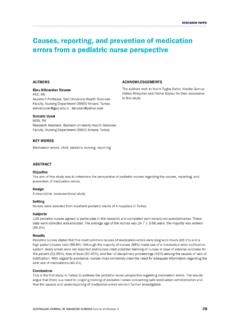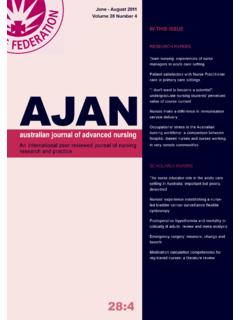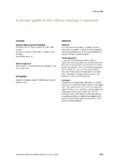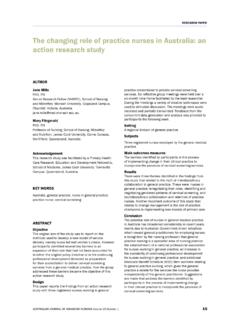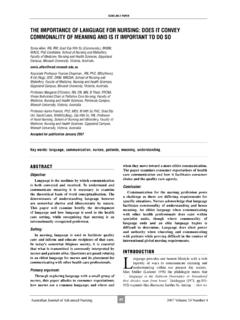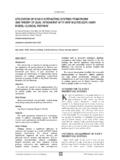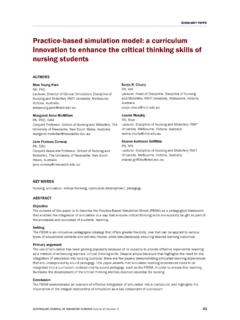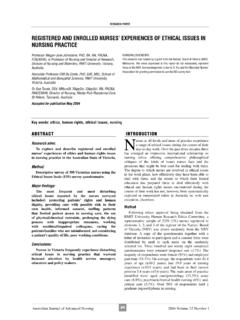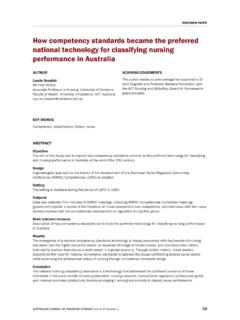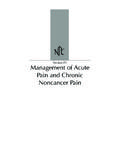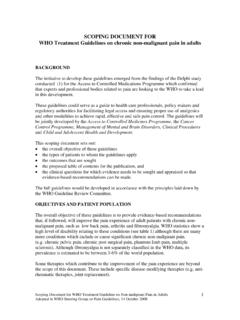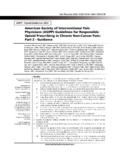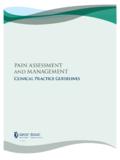Transcription of ASSESSMENT AND MANAGEMENT OF CHRONIC PAIN IN …
1 33 Australian Journal of Advanced Nursing 2006 Volume 24 Number 1 SCHOLARLY PAPERABSTRACTAim:This paper reviews the nursing research literatureon CHRONIC pain in the older person living in thecommunity and suggests areas for future : CHRONIC pain is a pervasive and complex problemthat is difficult to treat CHRONIC pain in older people indomiciliary/home/community nursing settings facemanychallenges. To provide care,the manyparameters of CHRONIC pain which include the physicalas well as the psycho-social impact and the effect ofpain on patients and their families, must be of the older person about pain andpain MANAGEMENT are also :Relevant nursing studies were searched usingCINAHL, Cochrane Database of Systematic Reviews,EMBASE and PUBMED databases using key wordsabout pain and the older person that were appropriateto each :Tools to assess pain intensity in the older personhave been studied but there has been less research onthe other parameters of pain ASSESSMENT or how theolder person manages pain .
2 An effective nurse-patientrelationship is an important component of this processand one that needs more studieshave focused on how nurses can be assisted, or on thechallenges,nurses face,when managing thisvulnerable :Abroad approach at the organisational level willassist nurses to manage this health care :I would like to acknowledge the assistance of PaulaTognazzini,MSN Instructor and Post RN Advisor,University of British Columbia School of Nursing andKathy Gregg, MSc and Clarissa Tsang BSN, ResearchAssistants in the preparation of this pain is a significant health problem for olderpeople living in the community. The prevalence rate isdifficult to determine but researchers in Australia andoverseas have found between 27% (Blyth et al 2001) and51% (Helme and Gibson 1997) of those over 65 yearsreport CHRONIC pain .
3 In those 85 years and older, theprevalence rates are higher as researchers report that asmany as 70% of older persons who live in communitysettings report pain (Brochet et al 1998; Roy and Thomas1987; Scudds and Robertson 2000). This high prevalenceis a concern as CHRONIC pain , particularly in the older person,is not well-treated (Ferrell et al 1990; Pitkala et al 2002). CHRONIC pain affects all aspects of an individual s lifeand has a major impact on health services. A Canadianstudy reported over of older people receiving homenursing had been troubled by pain in the past two weeks(Ross and Crook1998). Managing CHRONIC pain in theolder person is an important nursing responsibility;however, most research that guides nursing practice hasbeen conducted in acute care or nursing home research about managing CHRONIC non-malignantpain in non-institutionalised older persons is limited.
4 The purpose of this paper is to review the nursingliterature on ASSESSMENT and MANAGEMENT of CHRONIC painin older persons in a community setting and to suggestareas for further research. Relevant nursing studies, in English, were searched inelectronic databases up to July 2005. Neoplasms andpalliative care studies were excluded and a limit of age 65and older imposed. Databases included: CINAHL (1982-)using keywords: aged, CHRONIC pain , community healthnursing; Cochrane Database of Systematic Reviewcombined aged, CHRONIC pain , community care withcomplementary and alternative medicine; EMBASE(1996 ) using keywords aged, CHRONIC pain and homeservices: PUBMED (1967-) using MeSH terms: aged, pain , pain ASSESSMENT , home care Dewar RN, PhD, Associate Professor, School of Nursing,Wesbrook Mall, Vancouver, for publication December 2005 ASSESSMENT AND MANAGEMENT OF CHRONIC pain IN THE OLDER PERSONLIVING IN THE COMMUNITYKey words: CHRONIC pain , older people, domiciliary/home/community care nurses, pain ASSESSMENT , paininstrumentsAustralian Journal of Advanced Nursing 2006 Volume 24 Number 1 SCHOLARLY PAPER34 LITERATURE REVIEWA ssessment of CHRONIC painPain ASSESSMENT in the older person is particularlycomplex because of other underlying health issues,polypharmacy, and increased sensitivity to pain -relievingmedications.
5 A range of other factors such as the patient sbeliefs and attitudes toward pain and analgesicmedications, health professionals lack of knowledge andlack of understanding about the complexity of chronicpain, and even organisational barriers, add to the problemand complicate the nurse s role. CHRONIC pain affects all dimensions of an individual s life: physical;psychological; social; and spiritual, and data should begathered on all these aspects as well as the meaning ofpain for the individual. CHRONIC pain can interfere with the older person sabilities to perform activities of daily living (ADLs). Indomiciliary/home/community care settings, researchershave found that older people with CHRONIC pain requiremore assistance with ADLs from domiciliary/home/community care nurses than those who are pain free(Ross and Crook 1998).
6 CHRONIC pain can also affectappetite (Bosley et al 2004) and sleep (Ferrell et al 1990;Ross and Crook 1998). Researchers in other fields havenoted that painintensity has the most impact on the older person sphysical functioning, but other pain characteristics whichinclude location, onset, duration, frequency, and pattern(continuous or intermittent) also have an effect. Forexample, pain that is continuous but of moderate intensitycan be just as disabling as severe pain that is intermittent(Lichtenstein et al 1998). (Disability is defined asdifficulty performing three or more activities of dailyliving). Level of disability also increases if more than onebody site is affected (Lichtenstein et al 1998). Falls in theolder person have also been linked to CHRONIC pain (seeVarela-Burstein and Miller 2003 for a review), andalthough all the particulars of the association are notclearly understood, it is postulated that pain may causeindividuals to modify their ADLs.
7 These modificationscan lead to problems of balance and loss of physical conditioning which can predispose to used for sleep and for pain relief maycontribute to falls the older population, nursing investigators havefocused on which tools measure pain intensity community settings, ASSESSMENT tools havebeenstudied to determine if some instruments are too abstract,particularly when cognition is a problem. The followingtools have been researched using older persons incommunity settings as the population: verbal descriptorscales (VDS) (Benesh et al 1997; Herr et al 2004; Taylorand Herr 2003); the vertical visual analogue scale VAS[v-VAS] (Benesh et al 1997; Herr et al 2004); temperaturescales (PT) (Benesh et al 1997; Taylor and Herr 2003);numerical rating scales (NRS) (Benesh et al 1997; Taylorand Herr 2003; Herr et al 2004); verbal numerical ratingscale (VNS) (Herr et al 2004); and faces pain scales(FPS) (Herr et al 1998; Herr et al 2004; Taylor and Herr2003).
8 Several researchers have concluded that thesecommonly used tools are valid and reliable for olderpersons, and many are suitable for those with mild tomoderate cognitive impairment (Ferrell et al 1995; Taylorand Herr 2003) if special provisions such as enlargedprint and careful explanations are made (Taylor and Herr 2003). There is less research on assessing the impact ofchronic pain on the psychosocial well-being of the olderperson living in the community. CHRONIC pain caninterfere with the older person s ability to shop, maintaintheir home and with family and social relationships (Rossand Crook 1998; Mobily et al 1994). The risk ofdepression increases with CHRONIC pain (Carrington Reidet al 2003; Lin and Taylor 1999; Ross and Crook 1998).
9 Because some of the symptoms of depression and chronicpain are similar, nurses may need to use a mental statusquestionnaire such as the Mini-Mental StatusQuestionnaire (Folstein et al 1975) in conjunction withpain ASSESSMENT measures to ensure that the patientreceives appropriate care (Herr and Mobily 1991).Cognition can be influenced by both pain and analgesics(McCaffery and Pasero 1999). One of the difficulties associated with pain assessmentis that the older person may be reluctant to report have suggested that stoic attitudes, fears ofaging, fears about medications, fears that pain means theymay not recover, are commonly held beliefs about painand pain MANAGEMENT (Ferrell et al 1990; Herr andMobily 1991; Muonio 2004).
10 Investigators in long-termcare settings suggest that the older person may not wantto bother nurses and believe that complaining mayalienate health professionals and drive away their limitedsocial support (Ferrell et al 1990; Yates et al 1995).Conversely, some clinicians suggest that older personsmay report pain instead of other symptoms as pain ismore acceptable to report than physical losses, lonelinessand boredom (Herr and Mobily 1991). The language used by older persons to describe theirpain may differ, as they may not refer to a problem as painbut instead use terms likesoreness or annoying(Miaskowski 2000). Obtaining accurate pain reports fromthose with dementia is a ntyselka et al (2004) found that the older personwith dementia living in the community, as assessed by ageriatrician, reported less pain and used less analgesicsthan those who did not have dementia.

